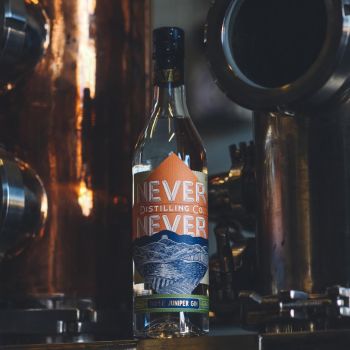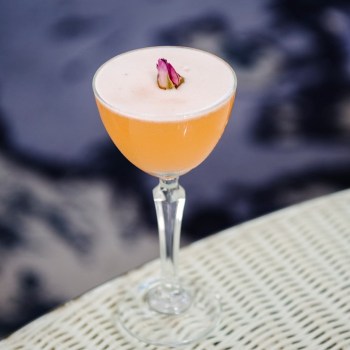By Aristine Dobson. This article first appeared in Hospitality.
New York-Based Bartender and Attaboy Co-Owner Sam Ross was asked to develop a new cocktail for The Violet Hour in Chicago. Ross was up for the challenge and enlisted the help of the late Milk & Honey Founder Sasha Petraske, with the pair coming up with a drink that combined equal parts Campari, bourbon, Amaro Nonino and lemon juice in 2008.
The Campari was later replaced with Aperol to mellow out the bitterness, resulting in a harmonious drink that would go down in history as a modern classic — the Paper Plane.
Named after the hit M.I.A. song Paper Planes, the cocktail quickly gained traction among patrons and became the top order at The Violet Hour. It was equally lauded by industry professionals for its balance and has remained front of mind for bartenders the world over.
Hospitality speaks to Francesca Camilli from Beneath Driver Lane and Anneliese Grazioli from Hanky Panky Lounge about choosing the right spirits for the job, how not to overdilute the drink and why the Paper Plane is ready for its return.
Despite its soaring popularity during the early aughts, the Paper Plane is not often found on menus in Australia. Beneath Driver Lane’s Francesca Camilli believes most patrons are unfamiliar with the drink, let alone what goes into it.
“Many people don’t know about the Paper Plane because it has Amaro Nonino in it, which is quite a unique ingredient,” says the Melbourne-based bartender.
“I don’t think people have any idea what it is, unlike a daiquiri. But I think it should be more popular.”
Although the Paper Plane is not currently lauded among the drinking public, Francesca rates it as a “bartender’s drink of choice”, praising it for its flavour profile.
“I love the Paper Plane because it mixes four ingredients I love,” she says.
“It’s a simple drink and it’s very balanced because it’s equal parts of every ingredient.”
Owner of Hanky Panky Lounge Annaliese Grazioli was initially puzzled by the Paper Plane when she first discovered it.
“[Sam Ross] basically picked all these ingredients that usually stand up in drinks on their own and put them together,” she says. “He sounded like a mad scientist, but it came out really well and I think bartenders are intrigued when they see it.”

Annaliese describes the drinking experience for those who have never tried the drink before: “You get all the components straight up, so it’s interesting trying to decipher it and break it down,” she says. “To get all that on your palate straightaway is awesome. I’ve had it a few different ways at different bars.”
The Paper Plane drew inspiration from a prohibition-era cocktail called the Last Word which combines equal parts gin, green chartreuse, maraschino liqueur and lime juice. Both use a 1:1:1:1 ratio to maintain an equilibrium of flavours.
“You need an ounce of bourbon, Aperol, Amaro Nonino and lemon juice,” says Francesca.
“It’s sour because of the lemon, lush from the Amaro Nonino and the bourbon and bitter from the Aperol.”
Although Beneath Driver Lane doesn’t list classic cocktails on its menu, Francesca is more than happy to make a Paper Plane upon request. If she does, the bartender never strays far from the original recipe. “If someone wants a classic — and we get a lot of hospitality people ordering classic drinks — we make them,” she says.
Hanky Panky Lounge isn’t afraid to venture from the norm when it comes to recreating the Paper Plane.
“I’ve tried it with the original specs and twists and they all seem to work really well,” says Anneliese.
“It’s not [listed] on the menu because we don’t have Amaro Nonino or Aperol here. We adapt to what patrons want to order and explain how it will be different. Most people are keen to try a twist anyway.”
Anneliese has riffed on the cocktail with various substitutions.
“We used to do one with Saint Felix, an Australian aperitif, and Amaro Montenegro,” she says.
“The Montenegro is a lot softer than Amaro Nonino, but Saint Felix is a little more bitter than Aperol so it balanced out nicely.”
Selecting and measuring the ingredients is perhaps the easiest part of making a Paper Plane.
“It’s kind of hard to stuff it up,” says Anneliese.
“Obviously, it could happen, but make sure you stick to the right specs. If you are swapping out things like the amaro or the aperitif, you need to balance everything because they’re not equal bitterness and sweetness.”
Choosing the right kind of bourbon is integral when building a Paper Plane, with the liquor providing body to the drink.
“You wouldn’t use a peated whiskey because it would take the drink in a completely different direction,” says Francesca.
“It’d be an interesting and fun experiment, but I think bourbon is more palatable as it has a vanilla finish. You get more creaminess than any other kind of whiskey and it’s sweeter, which contributes to the drink.”
The sweetness that bourbon has comes from oak barrels and is exemplified by Kentucky brands such as Buffalo Trace and Knob Creek. Anneliese tips both makers as her top picks for the Paper Plane, but customers can choose other options.
“I’d go through a couple of bourbons if they didn’t know the profiles,” she says. “I really like Maker’s Mark and the sweetness that comes from the high wheat. Woodford Reserve or Basil Hayden also come close, but are probably a bit much for the cocktail.”
The Paper Plane may comprise only four ingredients of the same measurements, but technique is still required to ensure the drink is properly executed. Francesca always puts spirits and liqueurs in a shaker before the citrus juice and the ice to prevent overdilution.
“You always add citrus and ice at the end because it changes the flavour,” she says. “You shake and make sure your glassware and mise en place is ready to go. It’s all about serving the drink straight away and trying to maintain the integrity of the drink for as long as possible.”

The mixture is double strained to weed out any ice chips or citrus pith, resulting in a smooth and thin texture. “Double straining means you’re straining the drink with a Hawthorne and then a kitchen [sieve],” says Francesca.
Keeping an eye on the dilution level is key and all comes down to the type of ice used. Large-format cubes are shaken with the formula and left behind once the drink is poured.
“You want to have big ice because you don’t want to overdilute,” says Francesca. “It’s a quick, sharp shake so the ingredients mix together and you dilute it a little bit. You don’t want to overdo the drink, so don’t shake it for too long.”
Hanky Panky Lounge uses ice from its trusty Hoshizaki machine, which spits out hefty ice cubes.
“It’s pretty chunky and we can control the dilution better,” says Anneliese.
“It’s not particularly cold in Darwin, so we want to make sure the drinks are at a good temperature. If we can control one thing, it’s making the ice the best size possible.”
For a drink as punchy as a Paper Plane, a Nick and Nora glass or a coupe ensures a longer-lasting beverage. Keeping the glassware cold is also essential for a drink served without ice.
“It’s got to be super cold with [the number of] botanicals in it and how fast it can change, so you want the glass to be cold,” says Anneliese.
“Temperature is really important in a drink that has so much going on.”
Originally, bartenders would honour the Paper Plane’s namesake by finishing off the cocktail with a hand-crafted paper airplane on the rim. While it makes for a unique garnish, it’s not entirely efficient for busy venues. A twisted lemon peel is an easier and equally sensory option.
“It’s hard to do better than citrus oils,” says Anneliese. “There are other ways to incorporate aroma with funkier garnishes, but for something like a Paper Plane, you don’t want to add something really technical or intense. You want something simple that adds aroma and looks good.”
The Paper Plane has influenced the modern bar world in a big way despite its low-key reputation. As a whiskey-centric bar, Beneath Driver Lane hopes to up public awareness of the drink and its counterparts. “There’s definitely been growth in the way people approach whiskey,” says Francesca.
“In the past, only men drank whiskey and had it neat or in an Old Fashioned. We challenge people’s palates so they’ll be like, ‘Oh, it’s a whiskey drink? I might try it’. The Paper Plane will probably make a comeback because it’s a whiskey drink.”
Anneliese hopes the cocktail will soon be as loved by patrons as it is by bartenders.
“I think it’s a great little twist on different cocktail genres, so it’s a middle ground for people who want something bitter but sweet and refreshing,” she says. “Patrons probably wouldn’t order it without a bartender’s recommendation, but in saying that, I have seen growth. Give it a couple more years and it will pop up.”
Want to see more from Hospitality? Subscribe to the newsletter here.



